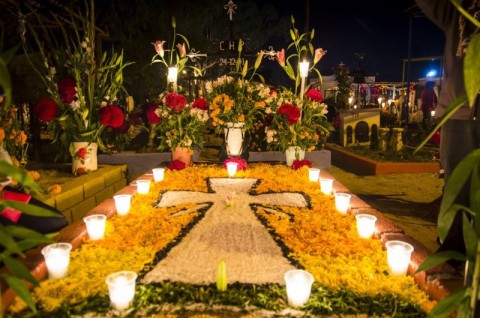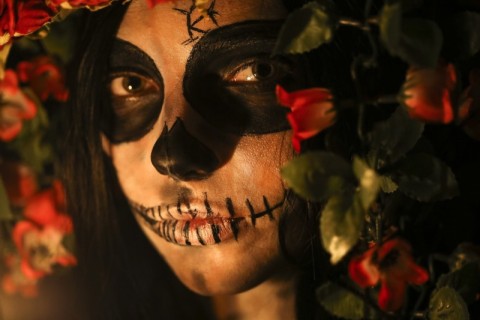A beautiful mix of culture, history, and tradition, Dia de los Muertos, or Day of the Dead is a beloved holiday celebrated all over Latin America. Every year in November families gather to celebrate the lives of loved ones lost. From colorful face painting to elaborate costumes and altar displays, this holiday represents the joy of Hispanic culture. While mostly celebrated in Mexican communities, the Day of the Dead festivities can be found in many Latin American countries. Infinity Insurance Agency Inc. is a proud supporter of the Hispanic community and is excited to explore the origins of this vibrant celebration.
Ready to uncover the history about the Day of the Dead? Read on…
What is the Day of the Dead and when is it celebrated?
The Day of the Dead is a holiday usually celebrated in Mexico on November 1st and 2nd each year. Unlike traditional holidays or events centered around death, the Day of the Dead is meant to be a joyous occasion that reunites the living and the dead. It is believed on this day that the border between the spirit world and the real world is lifted and souls that have passed on can be temporarily reunited with their living family members. It is common for Hispanic families to honor these deceased relatives with their favorite foods, music, and even photos displayed on altars called ofrendas. These ofrendas are also commonly decorated with candles and orange marigold flowers called cempasuchil.

What is the history of the Day of the Dead?
The ancient inspiration for the Day of the Dead can be traced back to thousand-year-old rituals celebrated in pre-Columbian Mesoamerica. The Aztecs and the Nahua people saw death as an important part of life to be revered, not feared. The Day of the Dead combines ancient Aztec customs with European traditions of All Souls Day, a holiday that Spanish invaders brought to Mexico starting in the early 1500s.
What are the symbols of the Day of the Dead holiday?
Sugar skulls, giant skeletons, and Marigolds oh my! Day of the Dead festivities are rich in symbolism. If you are lucky enough to participate in a Day of the Dead celebration you may spot some of the holiday’s most popular symbols including:
- Calaveras (skulls) - often made of sugar or clay, these miniature skulls can take many forms and can be found decorating families ofrendas.
- Calacas (skeletons) - skeletons of all shapes and sizes are used as decorations for the Day of the Dead, many times they will be shown smiling to represent the fact that death doesn’t need to be scary.
- Flor de Muerto (Marigolds) - due to their bright orange color these flowers are believed to attract departed souls. Their ethereal beauty symbolizes the fragility of life.
- Pan de Muerto (Day of the Dead bread) - this sweet bread is consumed throughout the holiday season and often features a small bone-shaped decoration on top.
- La Catrina - this elegant skeletal figure has become synonymous with the Day of the Dead and many people adopt her skull face makeup and black clothes.
How is the Day of the Dead celebrated?
Depending on the region, Day of the Dead can be celebrated with costumes, parades, and music. One of the most popular customs of the Day of the Dead is the ofrenda. Families build ofrendas (or altars for offerings) in the home or at a gravesite to honor relatives who have passed on. These altars are meant to be celebratory rather than somber and usually contain food, drinks, and other beloved items of the deceased. For example, if your departed Tio loved mezcal and playing guitar you would place those items on your ofrenda along with an assortment of candles, flowers, and photographs, on top of a brightly colored oilcloth. A delicious way to celebrate the Day of the Dead is by sampling traditional foods such as Pan de Muerto, and tamales, or sipping a corn-based drink called Atole.

Do different countries celebrate differently?
From Mexico to Guatemala, countries all over the world have adopted creative ways of celebrating the Day of the Dead:
- U.S. - today many Hispanic communities have brought the Day of the Dead traditions to life, including San Antonio where visitors and locals alike can participate in a two-day Muertos fest featuring food, live music, and altars.
- Mexico - throughout Mexico you can find lively Day of the Dead celebrations, one of the most renowned is the famous Desfile de Dia de Los Muertos in Mexico City. This show-stopping parade contains dramatic costumes, music, and lots of Catrinas (skeletons)!
- Guatemala - refers to their celebration as the Festival de Barriletes Gigantes or “the Festival of Giant Kites.” During this time, families honor their dead by flying large artistically decorated kites to communicate with their relatives.
- Peru - every year Peruvians celebrate their Dia de los Muertos on November 2nd. Families bring food, blankets and chairs to the cemetery and reminisce about their lost loved ones. Cleaning the gravesite and decorating a small glass box to reflect the person's life and personality is also customary.
- Ecuador -here Day of the Dead is known as El Día de los Difuntos, or the day of the deceased. Families will congregate at cemeteries and hold vigils with prayers, food, and songs. Many meals will contain guaguas de pan, a sweet bread, and colada morada, a thick and fruity drink.
- Nicaragua -honors the Day of the Dead with slightly more somber celebrations that include a respectful trip to the cemetery to clean and even repaint their family tomb. Family members will also bring flowers to show their respect for departed loved ones.
The Day of the Dead in movies
Due to its fantastical visual elements, it's no surprise that the Day of the Dead has been featured in many popular movies including Disney’s Coco, James Bond’s Spectre, and The Book of Life.
Is Day of the Dead Mexican Halloween?
While the Day of the Dead and Halloween may seem to share some similarities (colorful costumes, skulls, and sweet treats) but these two holidays are distinctly different. The Day of the Dead is not Mexican Halloween, which was originally started as a pagan Celtic celebration to ward off ghosts.
Infinity Insurance Agency is committed to supporting the Hispanic community. From cultural celebrations to car insurance, we are committed to offering personalized insurance options.
Reach out to a qualified Spanish-bilingual agent at 1-855-478-3705 to receive a free auto estimate today!
